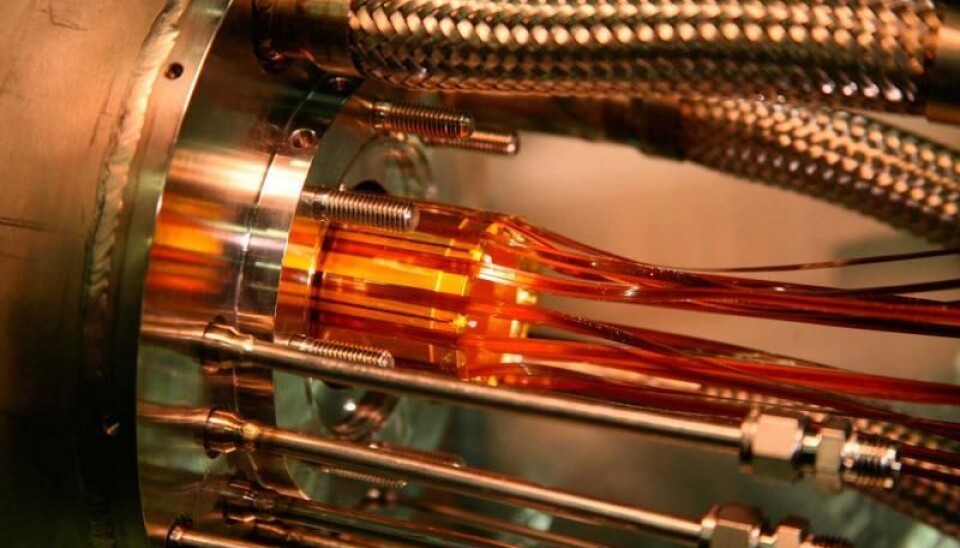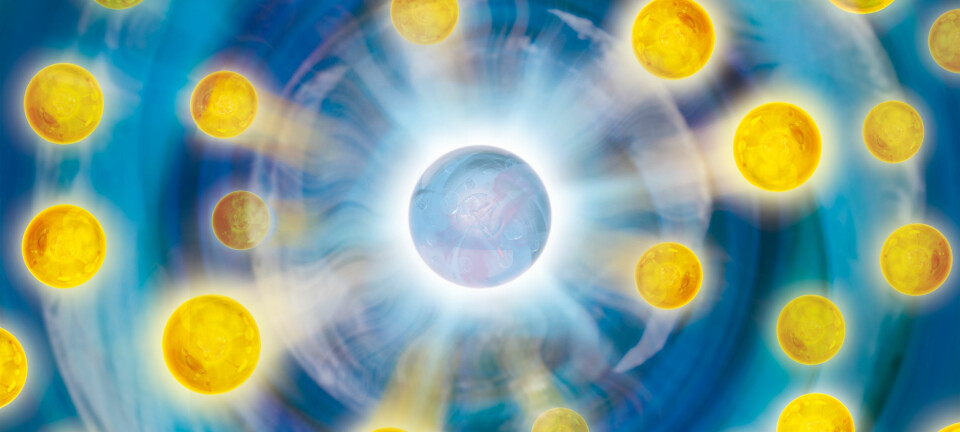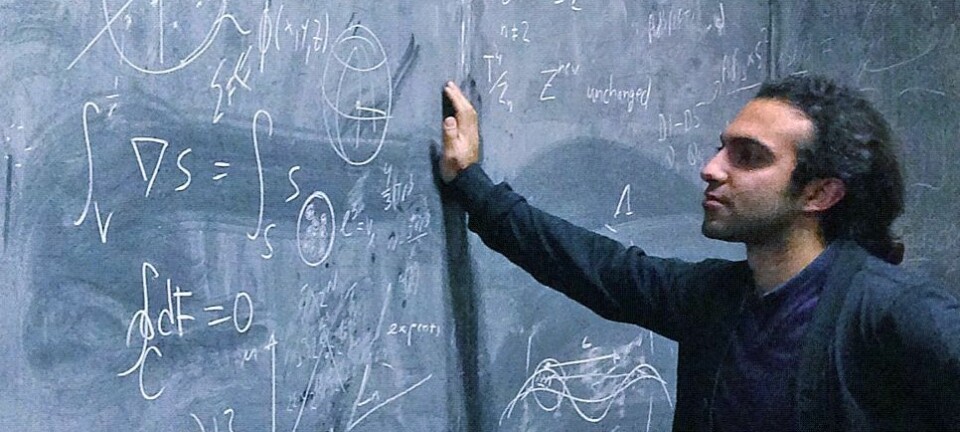
CERN makes first precise measurements of antihydrogen
Physicists edges a step closer to understanding antimatter after making the first precise measurements of antihydrogen’s electric charge.
A team of physicists has managed to make the first precise measurements ever of the mysterious twin of the hydrogen atom: antihydrogen.
With the aid of advanced equipment at the CERN research institute in Switzerland, the scientists managed to let antihydrogen atoms loose one by one and measure their electric charge.
“It’s the first time antihydrogen has been measured so precisely,” says Jeffrey Hangst, a professor at the Department of Physics and Astronomy at Aarhus University and the leader of the international research collaboration ALPHA at CERN. “To us it’s ground breaking that we’re even able to do it,”
The ALPHA group is behind the new study, recently published in Nature Communications.
What are antiparticles?
According to the prevalent theories in physics, antiparticles are completely identical to ‘regular’ particles -- except for the fact that they’re oppositely charged.
If a proton, which is part of an atom, has a positive electric charge, its antiparticle, an antiproton, has a negative charge.
In that way, antiparticles are precise reflections of all the particles we learn about in physics class – and which the world around us is composed of.
The mystery of the missing antimatter
“It’s one of the most fundamental questions in physics why the world around us consists of matter and not antimatter,” says Hangst. “According to the Big Bang theory the universe should have been created with matter and antimatter in equal measure, but all that’s left in the universe is matter.”
In other words: an explanation to why the large quantities of antimatter apparently disappeared from our universe is one of the major unsolved mysteries in physics.
“So our reason for doing this research is that we’re looking for something that can give us an explanation. That’s why we’ve worked to capture and describe antimatter for years -- to see if there’s a big difference between matter and antimatter that can give us an explanation.”
New precise measurements of antihydrogen
While the ALPHA team hasn’t found large amounts of naturally occurring antimatter in the universe, they’ve successfully created antimatter in their labs.
In 2010, Hangst’s research group secured a major breakthrough in antimatter research when they managed to produce and capture an antihydrogen particle.
Since then Hangst and his colleagues have refined their methods, and in the new study they successfully measured the antihydrogen’s electric charge.
As some may remember from physics class, a regular hydrogen atom consists of two different particles with an electric charge:
-
A proton, which has a positive charge and is situated at the core of the atom.
- An electron, which has a negative charge and circles around the core of the atom.
If you add up the electric charges of the proton and the electron, the hydrogen atom gets an overall charge of zero -- or rather: the hydrogen atom is electrically neutral.
The structure of antihydrogen
In line with this, physicists believe that the ‘opposite twin’ of the hydrogen atom consists of two different antiparticles with an electric charge:
-
An antiproton (the antiparticle of the proton), which has a negative charge and is placed at the core of the hydrogen atom.
- A positron (the antiparticle of the electron), which has a positive charge and ‘circles’ around the core of the hydrogen atom.
According to the physicists’ theories, the rules about charge in hydrogen should apply to antihydrogen, too -- making antihydrogen neutral, like its regular twin.
“You look at the sum of the respective electric charges of the antiproton and the positron, and if the theories are correct, it will mean that antihydrogen is neutral. But antihydrogen has never been measured before, and in physics we like to measure things before we can be sure of anything,” says Hangst.
“If our measurements had shown that antihydrogen wasn’t neutral we’d have a big problem in terms of theory,” he says. “All of our theories are based on the assumption that antiatoms are neutral, just like atoms.”
Theories confirmed
The results of the new measurements haven’t shattered or rejected any theories -- quite the opposite.
“With a precision of down to eight figures we have measured that antihydrogen is in accordance with being neutral. It’s the first measurement that’s been done on antihydrogen with that kind of precision. We’re still nowhere near having measured the charge with the same precision as with hydrogen, but it’s still a major step forward,” says Hangst.
At the Niels Bohr Institute at the University of Copenhagen Professor Peter Hansen agrees that the new study is a “significant improvement” of the antihydrogen measurements.
“Both the hydrogen atom and the antihydrogen atom should be electrically neutral according to the fundamental assumptions. It would be surprising, to put it mildly, if this prediction should turn out not to hold true. But all the more reason to test it accurately,” says Hansen in an email to ScienceNordic.
He hasn’t taken part in the new study, but he is affiliated with CERN where he studies particle physics.
How the measurements were done
But how did the researchers manage to carry out the new measurements of antihydrogen?
Hangst explains that they have used an advanced machine at CERN by the name of ALPHA. The machine works as a trap that captures antihydrogen atoms by freezing them down to extremely low temperatures.
“With our technique we can catch antihydrogen atoms, and afterwards we set them free one by one. When we’ve let them all loose, we add an electric field, and that means that if antihydrogen isn’t electrically neutral – if there’s an imbalance between the charge of the positron and the antiproton – then the antihydrogen atom would feel the power when it’s on its way out of our trap,” says Hangst.
In other words, the physicists looked into the behaviour of antihydrogen in the presence of an electric field.
According to the physicists, antihydrogen would be affected by the electric field if antihydrogen had an electric charge of its own, while it would move in an unaffected path if it were electrically neutral.
386 measurements
In the new study, the physicists measured a whopping total of 386 antihydrogen events. Based on the measurements they could set up an interval where the charge of the antihydrogen could be placed.
For the physics enthusiasts: the results of the measurements showed that the value of antihydrogen’s electric charge in relation to the fundamental charge, i.e. the electron’s charge, must be -1.3±1.1±0.4) × 10-8 (where plus and minus represent statistical and systemic uncertainties in the measurements).
Even though Hangst and Hansen both regard the new study as progress in the exploration of the world of anti-atoms, they both point out that there’s a long way to go before we can fully understand the mysterious antimatter.
“But just a few years ago it was simply impossible to carry out measurements of this kind. I’m not saying that measuring antihydrogen is becoming routine, but now we can talk about antihydrogen physics as a branch of physics. And we’re proud to contribute to that,” says Hangst.
This autumn Hangst will get a new machine which he can use to experiment on antihydrogen: the so-called ALPHA 2, which will be in operation at CERN. Hopefully it can reveal even more secrets of antihydrogen.
-------------
Read the original story in Danish on Videnskab.dk
(The video explains how researchers produce and capture antihydrogen. (Video: CERN (2010))
Translated by: Iben Gøtzsche Thiele









